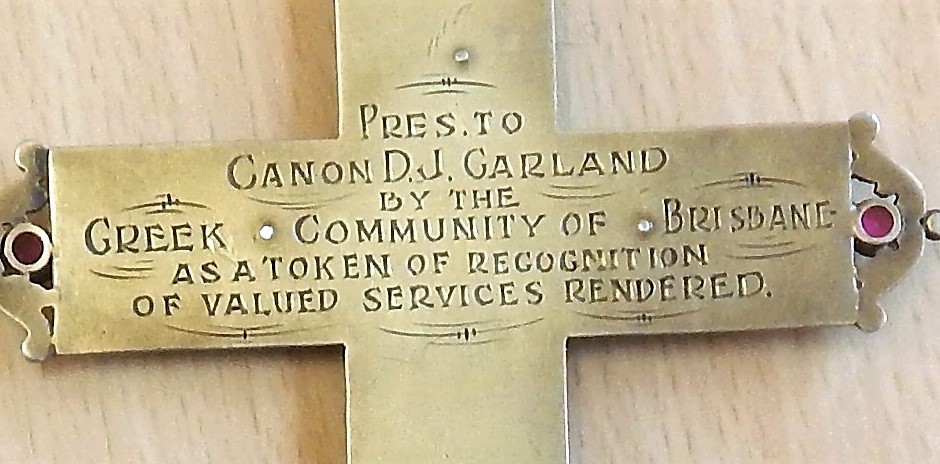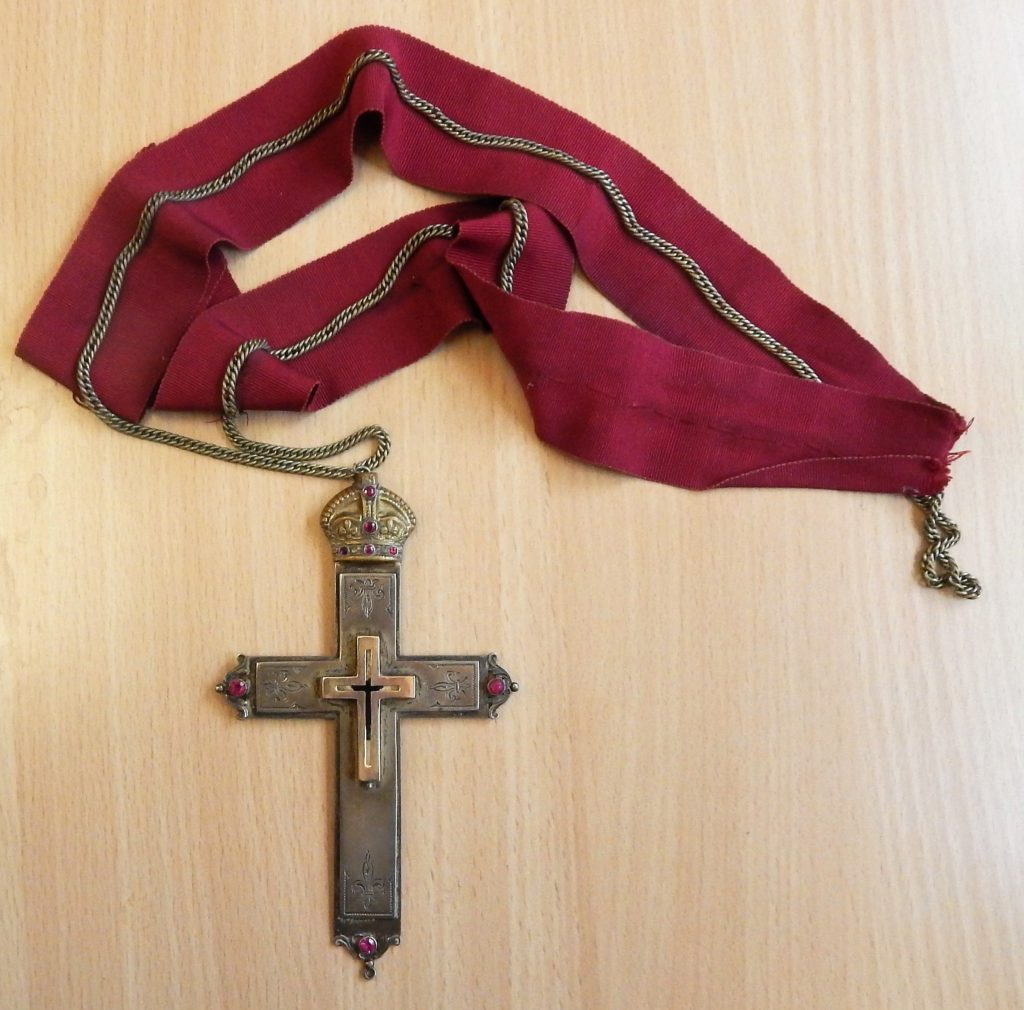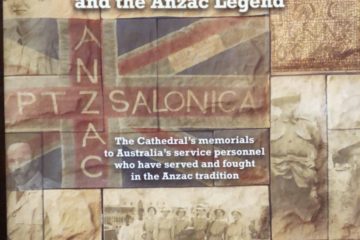The Pectoral Cross

ABOVE: The reverse side of the (Pectoral) Gold Cross of the Knighthood of the Order of the Church of the Holy Sepulchre. The inscription was added in 1924 by Brisbane jeweller, Bruce Phillips, on the instructions of a delegation from the local Greek Orthodox worship community, centred on St George’s Church, South Brisbane. Photo courtesy of St George’s Church, Whyke, Chichester.
IN 1920 the Reverend Canon David John Garland was conferred the Order of the Church of the Holy Sepulchre in the form of a small, gold cross.
In 1940 this priceless liturgical accessory, containing a holy relic, was bequeathed to a member of Canon Garland’s extended family in England. Every year since then, at Eastertide, the Pectoral Cross is laid upon the altar of a parish church in the Anglican Diocese of Chichester.
The Patriarch of Jerusalem, His Beatitude, Constantine Damianos, made Canon Garland a Knight of the Church of the Holy Sepulchre in July 1920 “in appreciation of his great interest and reverence for the Holy Orthodox Church of Jerusalem and the Holy Sepulchre”.
A report that appeared in Rockhampton’s “The Capricornian” newspaper on 31 July 1920 (page 24), stated that a letter accompanying a diploma from The Patriarch, “gives the information that Canon Garland is the first priest of the Church of England to receive this decoration. It will be remembered that he (Garland) was the first to celebrate the Holy Eucharist in the chapel set aside for the Church of England at the Church of the Holy Sepulchre after the Turks were driven out of the Holy City and that since his return from Palestine he has advocated the claims of the Oriental Church upon the Church of England.”
As will be noted in the blog post, Canon Garland invested, there was an investiture ceremony performed on behalf of the Patriarch by Brisbane’s inaugural Acting Vice-Consul of Greece, Christy Kosmas Freeleagus, at St Barnabas’ Church, Red Hill, on Sunday, 10 July 1921.
Mr Freeleagus duly read out the diploma in Greek, with a translation of it in English, for the benefit the Ithaca-cum-Bardon congregation, as well as the sizeable delegation of visitors with Greek ethnic heritage.
As Canon Garland had only been the Rector at St Barnabas’ Church barely a year, the ecumenical collegiality on display almost certainly would have been confronting to those brought up on the forms and rituals outlined in the Book of Common Prayer.
Three years later, with his record of fellowship, fostering and encouragement of Brisbane’s Eastern Orthodox traditions – especially that of the ethnic-Russian community – now far better understood and appreciated, Canon Garland again played host to the now-Honorary Consul of Greece in Brisbane, Mr Freeleagus, at St Barnabas’ Church.
On Sunday, 12 October 1924, an overflowing congregation of parishioners and Greek community visitors witnessed Canon Garland ceremonially receive his knighthood and Pectoral Cross, again.
This time choristers who, by 1929, would formally belong to the Greek Orthodox Community of South Brisbane’s flourishing Parish of Saint George the Great Martyr, bolstered the numbers and added a distinctive Orthodox flavour to the morning’s service of worship.
It also just so happened to come a little over week since Canon Garland had marked his 60th birthday.
His beloved Pectoral Cross was now described as “of gold, and the stones are rubies. It was made Mr. Bruce Phillips”.
The city’s Greeks had been so taken by Canon Garland’s ceaseless advocacy on their behalf that many had contributed to a fund to pay for the Cross of the Holy Sepulchre to be reset into a larger piece of gold, using the talents of Brisbane jeweller, Bruce Phillips.

ABOVE: Edward Street, jeweller, Bruce Phillips, advertised his skillset in “The Telegraph” newspaper on 3 October 1921 (pg6). Mr Phillips was engaged to inscribe these words on the reverse of the Pectoral Cross: “Pres. to Canon D.J. Garland by the Greek Community of Brisbane as a token of recognition of valued services rendered.”
Described in Canon Garland’s 1938 Last Will and Testament as “containing three splinters of the TRUE CROSS”, the centrepiece was now affixed to a bigger gold cross, flanked by an engraved Fleur-de-lis at the extremity of each arm and encrusted with a small ruby; topped by a stylised motif of St Edward’s Crown, itself set with four rubies – a nod to Canon Garland’s fealty to the King and British Empire – and finished out by a gold chain set into a deep maroon-coloured ribbon (see close-up photograph below), finally enabling it to be worn in a style that priests of the Eastern Orthodox tradition would find familiar.
Along with his prized Pectoral Cross, Canon Garland also bequeathed its “certificate of identity, signed by the Patriarch of Jerusalem”.
On Sunday, 18 January 1920 – and presumably not yet aware that the Patriarch of Antioch (Jerusalem) was intending to bestow on him a knighthood – in his “Reunion of Christendom” sermon delivered at Brisbane’s St John’s Cathedral, Canon Garland described the pinnacle of his tour of duty as the First AIF’s Senior Church of England Chaplain in Jerusalem, between late 1917 and mid-1919:
“…the preacher [ Canon Garland ] had the great privilege of celebrating the Holy Eucharist on an altar, somewhere about 1,200 years old, in the underground church of St John the Baptist, in Jerusalem, assisted by a body of Australian troops, a celebration which the Patriarch of Jerusalem had said was the first celebration in that place of the Holy mysteries for 1,000 years. Christmas, a year back, he (the preacher) had the wonderful privilege of being received by the Patriarch of Antioch. At the Christmas Eucharist in the Damascus Cathedral, by direction of the Patriarch, he was vested in their sacred vestments, placed at the altar amongst the priests, and given the Holy Communion as a priest. Then in Jerusalem, at the Church of the Holy Sepulchre, with only a wall dividing the altar from Calvary, there was an altar erected by the Patriarch some 35 years ago in order that Church of England priests might celebrate the Holy Mysteries according to the use of the Book of Common Prayer, and where he (the preacher) had celebrated many times…”

ABOVE: Detail of the obverse side of the Pectoral Cross. Note the inlaid rubies. The tiny, gold, centrepiece crucifix – it is claimed in a certificate issued in 1920 by the Patriarch of the Greek Orthodox Church of the Holy Sepulchre – to contain “splinters of the TRUE CROSS”. Since it was bequeathed to Canon Garland’s nephew in the United Kingdom in 1939, the Pectoral Cross has been kept in a small wooden box which, in turn, is kept in a locked ambry cupboard alongside the High Altar of the Church of St George, Whyke, in the Anglican Diocese of Chichester. This cupboard is also use to keep the Holy Oils blessed by the Bishop at the Christmas Mass held in Chichester Cathedral and used at baptisms, unctions for the sick, and the like. The Pectoral Cross is taken out and placed on St George’s Church altar on Good Friday and for other festivals, particularly at the church’s patronal festival – St George’s Day – where some members of the congregation venerate it by kissing it as it is held by the priest. Photo courtesy of St George’s Church, Whyke, Chichester.
There was an Hellenic atmosphere at St. Barnabas’ Church, Red Hill, yesterday [ 12 October 1924 ], when Canon Garland [ David John Garland ] was invested with the Order of the Holy Sepulchre by the Consul for Greece (Mr. Christie Freeleagus).
There were many prominent members of the Greek community in Brisbane present, and during the service hymns in Greek were rendered by a soloist.
The Order of the Holy Sepulchre is one of ancient origin, and is said to have been founded by the Empress Helena, mother of Constantine the Great.
Helena was a British princess, whose son, born at York, became the Roman Emperor, and afterwards, sent his mother, the Empress Helena, to Jerusalem, where she built churches over the site of Calvary and of the Holy Sepulchre.
The Order was at one time given only to Royalty, and, is now bestowed very sparingly upon those who have shown some special devotion to the Church of the Holy Sepulchre.
It is the gift of the Greek Orthodox Patriarch of Jerusalem, who at present is His Beatitude Damianos, a Greek by birth.
The cross is of gold, and the stones are rubies. It was made Mr. Bruce Phillips.
— from page 8 of “The Brisbane Courier” of 13 October 1924.


